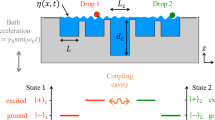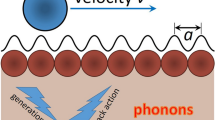Abstract
At a meeting of the French Academy in 1700, Bernoulli demonstrated that swirling mercury in an evacuated flask generates light1,2. He emphasized that this ‘barometer light’ “has not been explained since its discovery about 30 years ago” by Picard3. Here we revisit this phenomenon and find that the repetitive emission of light from mercury moving over glass is accompanied by the collective picosecond transfer of large numbers of electrons. When brought into contact with mercury, the glass acquires a net charge. This charge separation provides a force which, in our experiment in a rotating flask, drags mercury against gravity in the direction of the motion of the glass. Eventually the edge of the mercury slips relative to the glass, accompanied by a picosecond electrical discharge and a flash of light. This repetitive build-up and discharge of static electricity thus gives rise to stick–slip motion. The statistics of the intervals between events and their respective magnitudes are history-dependent and are not yet understood.
This is a preview of subscription content, access via your institution
Access options
Subscribe to this journal
Receive 51 print issues and online access
$199.00 per year
only $3.90 per issue
Buy this article
- Purchase on Springer Link
- Instant access to full article PDF
Prices may be subject to local taxes which are calculated during checkout



Similar content being viewed by others
References
Bernoulli, J. I. Sur le phosphore du baromètre. Histoire Acad. Roy. Paris 5–8 (1700); 1–8 (1701).
Harvey, E. N. A History of Luminescence (Am. Philosophical Soc., Philadelphia, (1957)).
Picard, J. Sur la lumière du baromètre. Mem. Acad. Roy. Sci. 2, 202–203 (1676).
Krim, J. Friction at the atomic scale. Sci. Am. 275, 48–51, 54–56 (1996).
Harper, W. R. Contact and Frictional Electrification (Clarendon, Oxford, (1967)).
Bowden, F. P. & Tabor, D. The Friction and Lubrication of Solids (Clarendon, Oxford, (1986)).
Bhushan, B., Israelachvili, J. N. & Landman, U. Nanotribology: friction, wear and lubrication at the atomic scale. Nature 374, 607–616 (1995).
Rabinowicz, E. Friction and Wear of Materials (Wiley, New York, (1965)); Polishing. Sci. Am. 218, 91–99 (1968).
Kemball, C. The adsorption of vapours on mercury. IV. Surface potentials and chemisorption. Proc. R. Soc. Lond. A 201, 377–391 (1950).
Hays, D. A. in Conference Series No. 48 265–272 (Conf. Ser. No. 48, Inst. Phys., (1979)).
Dybwad, G. L. & Mandeville, C. E. Generation of light by the relative motion of contiguous surfaces of mercury and glass. Phys. Rev. 161, 527–532 (1967).
Rayleigh, Lor Experiments upon surface-films. Phil. Mag. 33, 363–373 (1892).
Handbook of Chemistry and Physics 2989 (Chemical Rubber, Cleveland, (1954)).
Bernoulli, J. I. Nouvelle maniere de rendre les baromètres lumineux. Mem. Acad. Roy. Paris 178–190 (1700).
Barber, B. P. & Putterman, S. J. Observation of synchronous picosecond sonoluminescence. Nature 352, 318–320 (1991).
Hiller, R. A., Putterman, S. J. & Barber, B. P. Spectrum of synchronous picosecond sonoluminescence. Phys. Rev. Lett. 69, 1182–1184 (1992).
Barber, B. P. et al. Defining the unknowns of sonoluminescence. Phys. Rep. 281, 65–143 (1997).
Meek, J. M. & Craggs, J. D. (eds) Electrical Breakdown of Gases (Wiley, New York, (1978)).
Carlson, J. M., Langer, J. S. & Shaw, B. E. Dynamics of earthquake faults. Rev. Mod. Phys. 66, 657–670 (1994).
Demirel, A. L. & Granick, S. Friction fluctuations and friction memory in stick-slip motion. Phys. Rev. Lett. 77, 4330–4333 (1996).
Burridge, R. & Knopoff, L. Model and theoretical seismicity. Bull. Seismol. Soc. Am. 57, 341–371 (1967).
Rees, J. A. Electrical Breakdown of Gases (Macmillan, New York, (1973)).
Penning, F. M. Electrical Discharges in Gases (Cleaver Hume, London, (1957)).
Loeb, L. B. Fundamental Processes of Electrical Breakdown in Gases (Wiley, New York, (1939)).
Moore, A. D. Electrostatics (Doubleday, New York, (1968)).
Terris, B. D., Stern, J. E., Rugar, D. & Mamin, H.J. Contact electrification using force microscopy. Phys. Rev. Lett. 63, 2669–2672 (1989).
Lowell, J. Tunnelling between metals and insulators and its role in contact electrification. J. Phys. D 12, 1541–1554 (1979).
Kwetkus, B. A., Sattler, K. & Siegmann, H.-C. Gas breakdown in contact electrification. J. Phys. D 25, 139–146 (1992).
Raizer, Y. P. Gas Discharge Physics (Springer, Berlin, (1991)).
Acknowledgements
We thank L. Knopoff, T. Erber, J. Raffelski, G. Morales, S. Cowley, R. Löfstedt and P.H.Roberts for discussions, and E. Adams and C. Hiller for archival assistance. This work was supported by the US NSF and the US Department of Energy.
Author information
Authors and Affiliations
Rights and permissions
About this article
Cite this article
Budakian, R., Weninger, K., Hiller, R. et al. Picosecond discharges and stick–slip friction at a moving meniscus of mercury on glass. Nature 391, 266–268 (1998). https://doi.org/10.1038/34617
Received:
Accepted:
Issue Date:
DOI: https://doi.org/10.1038/34617
This article is cited by
-
Interfacial friction at action: Interactions, regulation, and applications
Friction (2023)
-
Charge mosaics on contact-electrified dielectrics result from polarity-inverting discharges
Nature Physics (2022)
-
Comparative efficacy of active and passive distraction during restorative treatment in children using an iPad versus audiovisual eyeglasses: a randomised controlled trial
European Archives of Paediatric Dentistry (2015)
-
Mechanically driven millimeter source of nanosecond X-ray pulses
Applied Physics B (2010)
-
Correlation between nanosecond X-ray flashes and stick–slip friction in peeling tape
Nature (2008)
Comments
By submitting a comment you agree to abide by our Terms and Community Guidelines. If you find something abusive or that does not comply with our terms or guidelines please flag it as inappropriate.



